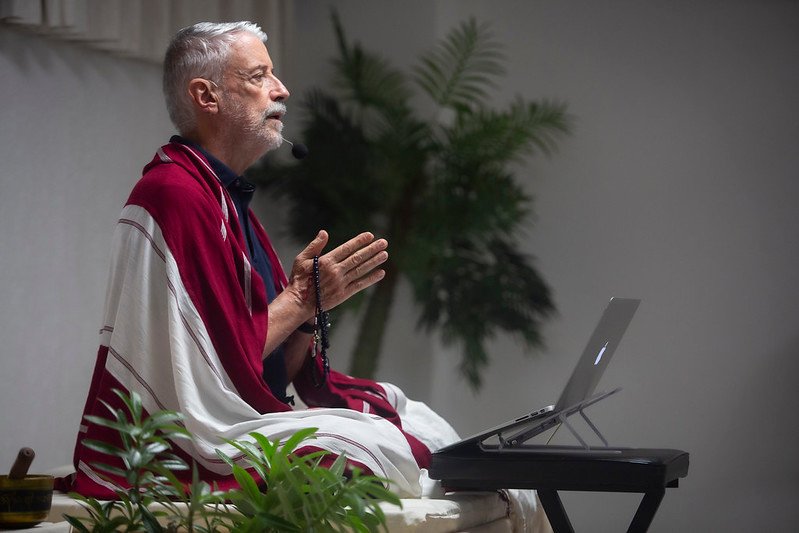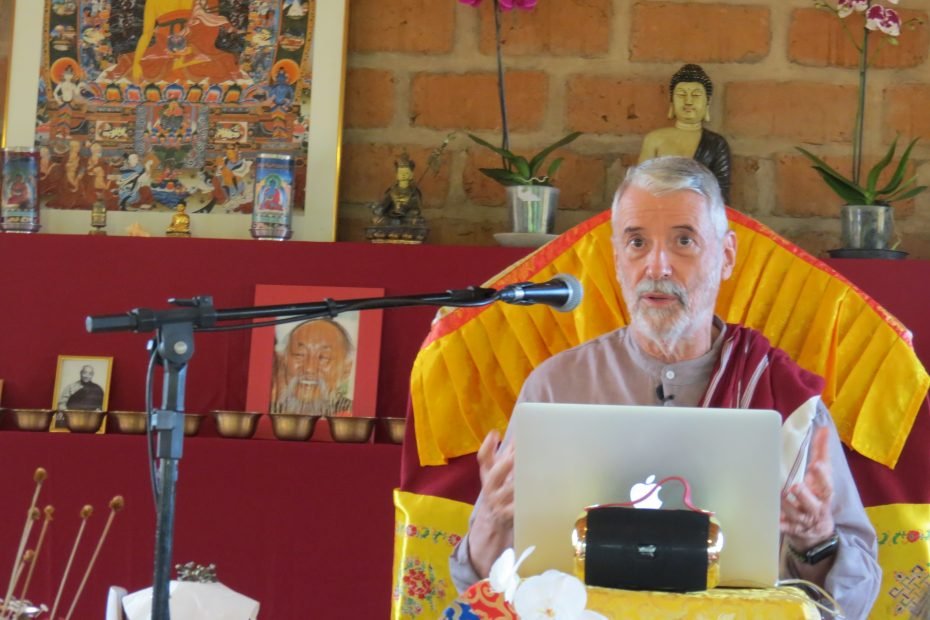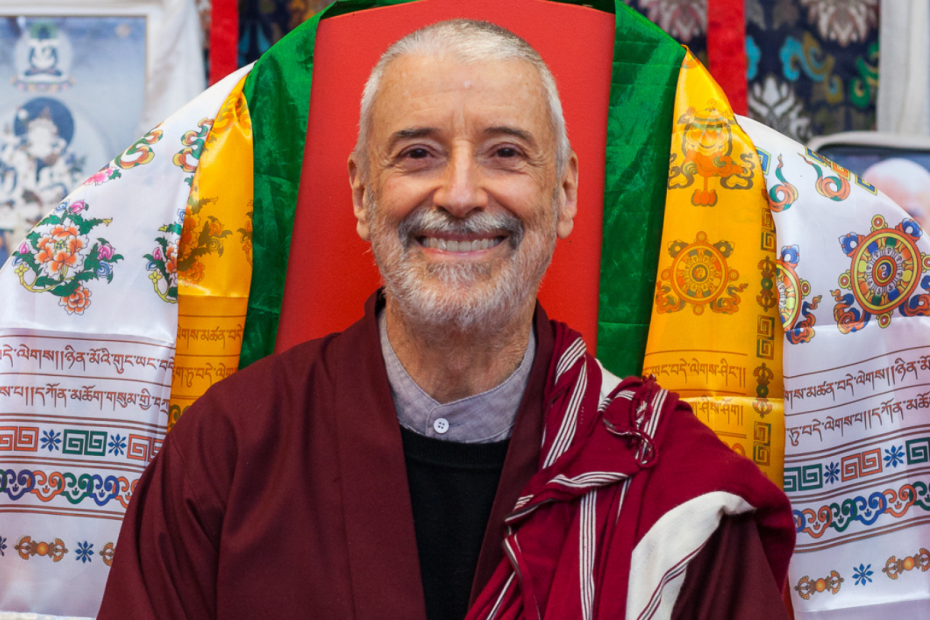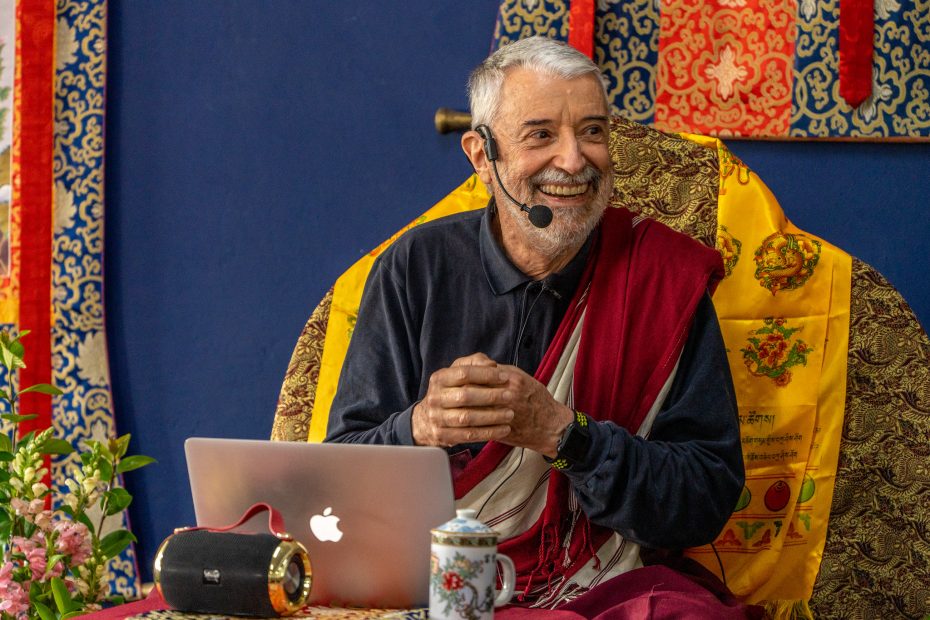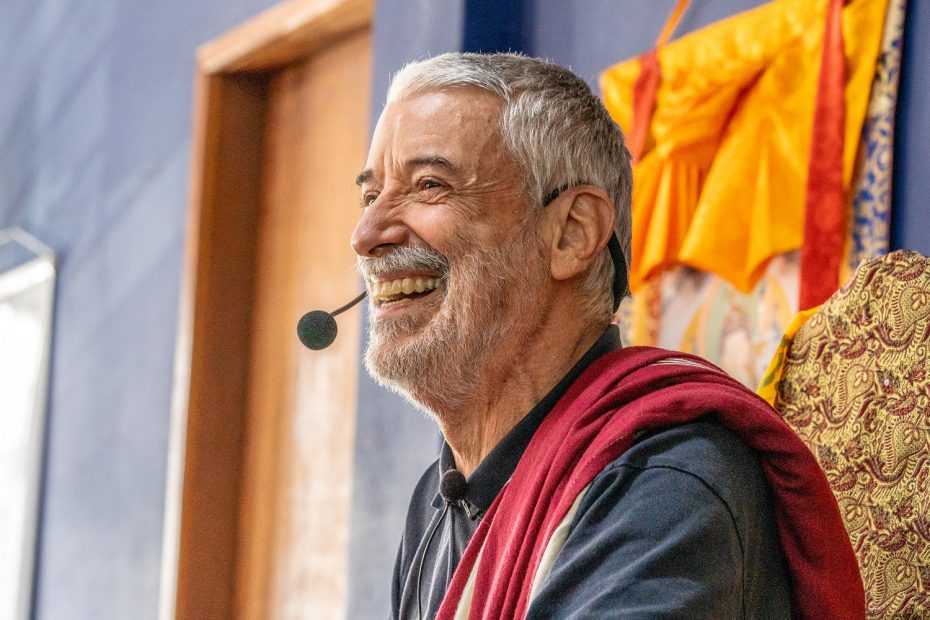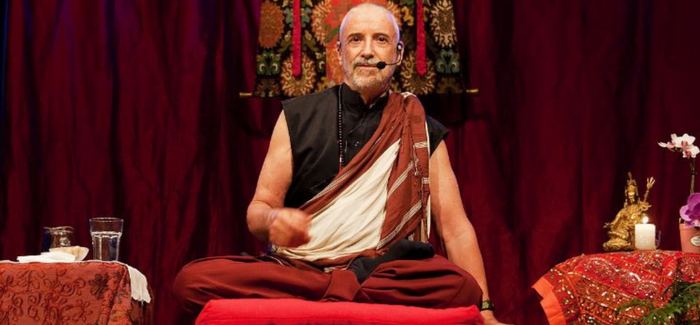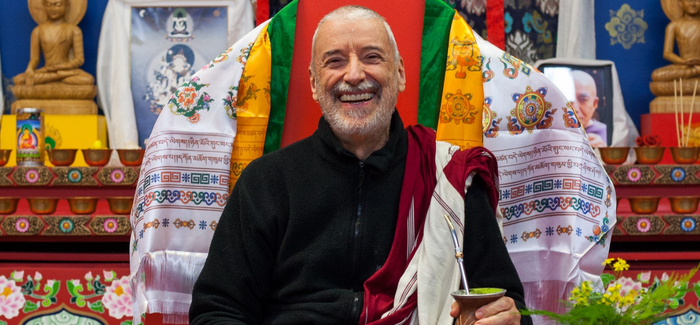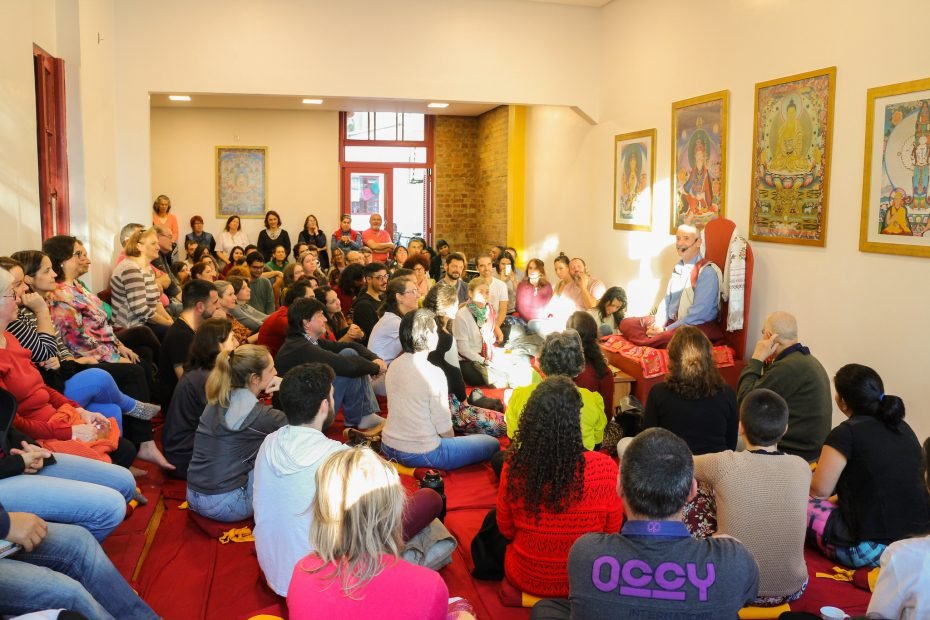The name for the worlds that emerge inseparable from our minds is “mandala”. Mandala does not refer only to a material world, but to the experience of this world, to the observer, the cognitive limits, the energies of action, the emotions and the body.
Each mandala emerges with an inseparable corresponding type of lively and active intelligence. This kind of intelligence is transcendent, not personal, not corruptible and free from time. Incessantly available, it can be recognized and accessed without effort or struggle at any moment. The Buddhist goal is to leave the limited mandalas and reach the mandalas of wisdom, immune to the binary standard of liking and disliking.
All beings aspire to happiness and shelter from suffering. Our parents teach us skills so that we come closer to happiness and protect ourselves. Our parents, teachers and masters also teach us discipline, and with that we enhance our ability to attain difficult goals, to cross disturbing and demanding environments and to deal with momentary adversities in search of further achievements. Buddhism teaches us the capacity of recognizing pure worlds and pure intelligence, so that, installed in the experience of these pure environments, the positive actions are naturally fulfilled without effort and without contradiction. These pure worlds are the mandalas of wisdom.
When we insert ourselves in a mandala of wisdom, we acquire the conditions for really doing what is better for us and others, for humanity and the environment. We are able to experience love and compassion with joy and equanimity, without falling prey to the difficulties which may appear. The world around us continues to be the same, but we change our way of seeing, and that changes everything. The purer and larger the mandala, the greater our freedom and capacity to generate good. Besides our personal insertion in mandalas of wisdom, as agents of the culture of peace, we try to help others to do the same and migrate to greater mandalas.
The synchrony of vision and action
The notion of mandala comes from the understanding that we build realities around us, and in doing so we also build ourselves. Then we realize what co-emerges as an inseparable process.
When we build favorable worlds and manifest wisdom, our positive action becomes natural, unblocked, compassionate and loving. From that moment on, the spiritual path focused on controlling the actions of body, speech and mind is replaced by the understanding that we must observe and direct the way we build ourselves together with these worlds. Building the world with lucidity, we will have a lucid body, lucid speech and lucid mind.
If we build the world based on ignorance, our body, speech and mind impulses will be based on this mistaken world vision that we develop. We can listen to the words of spiritual masters and try to follow their advices on how to use body, speech and mind, but everything is going to seem very artificial. Because the natural wisdom we use springs from the understanding we have of the world. From a mistaken understanding of the world nothing but mistaken impulses will spring.
Even being aware that the masters are correct, if we don’t develop the vision of the masters, our action will be contradictory and we will not see a solution, never have a rest, always be in internal conflict, never have a non-repressive behaviour. We will always be trying hard to follow the masters’ advice.
This effort produces a dramatic effect. We try so hard that one day we tire; when we reach this point, the fall is abrupt, and we say: “I give up. If spirituality were natural, I would walk naturally in a lucid and valid path. However, it seems to me completely artificial.” It seems artificial because we need constant effort, we never find a point of balance and must constantly try to recall what we hear. After so much effort, we finish by giving up.
We might wrongly believe that conventional reality is very powerful and far reaching. We might think, in spite of constructing a more elevated reality, that what really exists is the conventional reality of difficulties and suffering. We stop trying to improve ourselves and the world.
Trying to alter behaviour can be a very painful and slow way to reach uncertain results. The person who modifies her behaviour without changing her vision will certainly fall again further on. The cyclical aspect is a natural process of life, we go through ups and downs. Only from the mandalas of wisdom will we effectively have the vision that allows action without effort. The vision sprouts without effort because inside a mandala of wisdom we do not fight against ourselves, but we see and act naturally. The spiritual path presents itself without internal conflicts.
When one begins by training and by the obedience to rules, promises and actions, inner repression and outer discipline are unavoidable. Conflict becomes inevitable, and effort becomes constant and stressful. Our actions are coherent with our vision. If we are trained to act not in harmony with our world view, our actions will have no power.
I was able to watch boys learning to play violin in institutions for juvenile delinquents. To learn music is marvellous. But, when the boys leave the institution, the violin becomes useless to them. Very frequently they return to the view which made them do the actions for which they were sent to the institution. Even playing the violin, the views they have of the world, the family, and the neighbourhood did not change. Inside their reality, in their way of looking at the world, inside their limited mandala, naturally , selling drugs makes much more sense than playing the violin.
Thus , it is essential to generate a world view so that actions emerge naturally, without effort and without contradictions. The world views, which can be individually and socially generated, potentialize actions.
Everyone in the same mandala
We are inseparable from the mandalas in which we live. We may not even know which mandala we live in, but all of us live inside a mandala. Although we are all in the same place, in some sense we are not. Each one of us sees his or her experience in a certain way. In Buddhism, the experiences of reality are classified in six kingdoms – of gods, demigods, humans, animals, famished beings and hellish beings. In appearance, they all inhabit the same regions. However, in a subtle way, each one lives in a different place.
And where do the buddhas walking about the world live? They live in thatagatagarba, the mandala of the thatagatas. Thatagatas are buddhas who walk about the world. The thatagata and the beings from the six kingdoms walk in the same places, but he sees what the others can’t see: the natural perfection of everything. The thatagatas have a pure world view. This is the thatagatagarba experience. And this is the difference between any being from the six kingdoms and a buddha. The buddha lives in thatagatagarba, and the other beings live in their specific domains.
Buddhas are those who enter the mandala of lucidity. And in this mandala of lucidity, called Perfection of the Wisdom, the buddhas see all beings with a buddha nature, with a free nature. When buddhas see in this fashion, it is as if all beings were in the world of perfection, manifesting the qualities of ultimate nature – and they are! This is the buddhas’ view, an that’s why they are buddhas.
When buddhas enter thatagartabada, they do not enter individually; they and all beings enter at the same moment. To enter thatagatagarba, the buddhas need to recognize that all beings have buddha’s nature. This is a marvellous, extraordinary experience. It is not possible to enter alone, nobody sees the light alone!
When a buddha attains enlightenment, he develops a pure vision that allows all beings to be seen as buddhas. If anyone claims to have reached illumination having left out hopeless or undeserving beings, something is wrong. Buddhas see everything from the Mandala of the Perfection of Wisdom, from where they recognize all beings living beyond life and death. It is a space beyond space and time.
When we don’t have an ample view, when our vision is partial, we believe that only a few have buddha’s nature, that only a few are buddhas. This is a flaw in our view, a limitation. If our view is slightly increased, we will see that other beings are included in that list. The wider our view, the longer our list. Inclusion is, therefore, a recognized standard of the quality of our progress. From the moment we include the other, the other is with us inside the mandala. In the same way, from the moment we exclude the other, we too, unconsciously, leave the mandala.
If anyone is outside, it is because we likewise did not yet get in. So, we see, the impossibility of the other being in the mandala in practical terms signifies our own exclusion. Ours or someone else’s exclusion is the same thing. Imagining that some people are inside the mandala and others not, we are giving preference to someone. To give preference is to exclude. Exclusion and preference are the same thing. The impossibility of seeing buddha’s nature in others is the impossibility of manifesting qualities of a buddha. This is understanding unity, the inseparability of the mandala.
When contemplating our difficulties, it is important to have patience. We cannot ask ourselves more than we can offer – this is a reminder to be observed very carefully. We do have difficulties. As long as we cannot face them and release them, we will continue with them.
We let go of such fixations when we go beyond the private mandala through the experience of a greater freedom building other mandalas. Upon entering into a larger mandala, we look at private mandalas and conventional reality as minor constructions we no longer feel obliged to inhabit.
Let’s take a person, for example, who supports a football team. Even not admitting it, this person is not bound to the team. However much involved with the process, this person is free to support another team, or all of them at the same time. This is freedom amidst form.
We don’t free ourselves because we turn against what we were doing, but because we look from a more ample position and recognize that we have freedom of action. This is the point: we free ourselves because our mandala gets bigger; our view increases.
If we can lucidly face our difficulties, we can do the same with the difficulties of other beings. The lucid gaze at the difficulties of other beings is the gaze of Chenrezig, the Buddha of Compassion. With the gaze of Chenrezig, we forgive beyond forgiveness and non-forgiveness. Such forgiveness cures all manifestations of bitterness and resentment. There is no longer any view of opposition, fault or penalty regarding other beings.
From the perspective of the mandala, we don’t try to change our behaviour, for this is not the method for advancing. The idea is to change the mandala, because by changing the mandala we consequently change behaviour, but without effort. If, on the contrary, we try to change behaviour without changing the mandala, the result will seem twisted, clumsy, artificial.
When we advance to larger mandalas, we die at each step. We die with the limitations and are reborn in a more comprehensive way. In practical terms, we realize or even rehearse this expansion of our way of being in the world step by step. We do not succeed in one jump.
As a drill, we may begin, for example, with the four immeasurable qualities – compassion, love, joy and equanimity. We practice a view in which the four immeasurable qualities are something natural. Then we contemplate the common mandala or, in other words, the conventional world view in which compassion, love, joy and equanimity do not seem possible. We change mandalas and start looking at the same things without changing anything, without taking anything out of place. We change the eyes and the mandala, that’s how we start training. We ask: “Is it possible to have compassion, love, joy and equanimity? ” And we see that it is possible – it became possible.
We tend to believe that our efforts cause the transformations, but in the mandala’s approach effort only happens in the sense of changing mandalas, and not, actually, changing action. Efforts to change action never come to anything really stable. The great mandala allows for the natural, physical manifestation of all positive qualities and supports them without effort.
In conventional reality, our energy is moved by likes and dislikes, taking us near to what we like and far from what we dislike. Our intelligence is binary, our vision is binary. We are attracted or repelled by the experiences. Inside the binary vision, there is hedonism: “I want what’s good and that’s it. It is very simple; I already know what I want of life: the good things!”
Hedonism does not produce any stable result. When we only look for what we think is positive, we are wasting time. As soon as we find positive things, they begin to change. That which we found positive in the beginning becomes negative with time.
For example: a person begins to support a football team which is doing very well, winning championships. That naturally makes the person very happy, but soon things begin to change, and the team loses. Then the person suffers for the same reason she was happy before: supporting that team. The same thing happens concerning relationships, jobs and all other choices we make in life.
Generally, we make a hedonistic option, which does not mean that we get a hedonistic or even a sinful happiness. We find that anything prohibited and sinful tastes really fantastic. So, we run in that direction as if we were to find some extraordinary thing there. There is nothing, we do not find happiness.
Hedonism is a mistake. Nevetheless, we don’t need to be against hedonism. We only need to look at everything more thoroughly. When we catch sight of a mandala and see these points of reference which we use in a non-lucid fashion, we realize that we are going nowhere. Happiness is our destination, but hedonism is not a viable road. Understanding this, we try a gradual path that will take us to the mandala. This path is a higher vision. We keep magnifying our vision, and so we advance. Looking from the mandala’s perspective, our goal is to be born inside the highest visions, and to deliver others inside the same visions as well. This is the mandala.
The Culture of Peace Mandala
 In our action in the world, our prime objective will not be the individual, but the social. Instead of individual births inside the Mandala of the Culture of Peace, we will try to give birth to groups in the mandala. The social process is more important than the individual. When the culture of peace is socially established, that is, when a meaningful number of people relate to each other, establish a language and create a vision, this vision is a natural generator for several positive actions. Practical initiatives, projects, constructions, formations, and everything else blossom. A positive energy is present and gives life to everything.
In our action in the world, our prime objective will not be the individual, but the social. Instead of individual births inside the Mandala of the Culture of Peace, we will try to give birth to groups in the mandala. The social process is more important than the individual. When the culture of peace is socially established, that is, when a meaningful number of people relate to each other, establish a language and create a vision, this vision is a natural generator for several positive actions. Practical initiatives, projects, constructions, formations, and everything else blossom. A positive energy is present and gives life to everything.
From the mandala on, social work is no longer a kind of training in practical proclivities. It becomes a process in which the axis, the thread, the source of reference is that others be born for higher visions, and naturally, at some moment, for a view of the perfection of wisdom. The goal is that the various stages be a path in this direction.
Training to create skills to generate income is important, but the motivation should be elevated, not simply a shortcut to heighten a hedonistic process. If people generate income within a process of lucidity, that’s perfect. Income can be very useful. But to take income generation as a goal in itself is a mistake. It only keeps the hedonistic process going, making us dependent on external circumstances, and limited by a world perception based on our likes and dislikes, at the mercy of floating, uncertain and frustrating world configurations.
It is natural, from the hedonistic point of view, that we seek power; economic power included. Hedonism’s theoretical formulation converges toward an economic view of reality. Everything comes back to economics. With economic resources, we can find many people available to satisfy our wishes; we employ people to manipulate appearances for us.
Even in the culture of peace one may find approaches that are limited to income generation projects, economic means to manipulate external reality. People imagine that, having money, they will obtain peace and happiness. This is a mistake.
To produce peace, it is necessary to broaden our view, reach the mandala, abandon minor views. We need to look at people and say: “Yes, she can be in the mandala!” To look at our children and say: “He is in the mandala!” But that is not very easy. When we look at our children, in the culture we are in, we think: “He needs to be an engineer, a competent professional in some area, to earn money. Only then he will be happy.” Not even with our children we are able to have a mandala view; not even with ourselves.
Very often, our spiritual practice is tied to an economic view: “To have economic success I need stability. Then I will have the conditions to compete better, climb to high positions and earn more money.” With these motives we do not meditate to reach liberation, but to be more lucid and healthier, to obtain the common world results. This is the loss of the mandala view. We’ll get nowhere with that.
The mandala view is essential. Without correct vision, the very notion of culture of peace makes little sense and no longer is a solution. Within the notion of mandala we have a language for integrated work, and no need to isolate ourselves from the world. A gradual path appears, a thread which constitutes the deep source of reference for the apparently external actions in the world.
New Intelligence Managing Action in the World
Vision is essential to management, therefore we need a new intelligence. The difficulties we face today come from the fact that the education of our managers gives them an inappropriate view of reality. It leads them to circumstances in which inauspicious obstacles and signs multiply in all areas.
Economy and management clearly work in a subtle, volatile environment; not in a fixed, mathematical world. It is a world where feelings, emotions, impulses, dreams, and fears have the power to create reality and to define actions to be taken. We see the importance today of offering a broad approach to managers so as to better understand imponderable factors that keep floating before our eyes, affecting plans and dreams apparently so well structured.
Niels Bohr, the Physics Nobel Prize winner who devised the philosophical approach of quantum physics, the theory of complementarity, faced similar difficulties in the physics of the microscopic world, where the behaviour of matter seemed too strange and unpredictable. We especially owe to him the reintroduction of the importance of the observer’s role in constructing reality, that seems external to the observer. Niels Bohr demonstrated in academic terms that the non-inclusion of the observer’s influence in what seemed to be an external world disregarded a variable of the problem, producing ambiguities for understanding the relevant universes of study.
In a Buddhist language, things are always defined at a subtle level, we build worlds that seem external and are imprisoned in them. His Holiness the Dalai Lama, the Nobel Peace Prize winner of 1989, says that the mind is free and luminous, it can have positive and negative dreams. When its creation is a positive thing, the result is happiness and balance; when it creates negativeness, the result is suffering and troubles.
William James, as well as Ludwig Wittgenstein, by the end of the 19th century elaborated on the importance of understanding the role of the observer when dealing with reality. Essentially, our view is no bigger than the abstract space of the possibilities we dream of. The reality of our dream – it is a dream we have even awake – determines what can be seen and what will not be seen.
We are imprisoned in the worlds, systems of reference, options and dreams we build. Understanding this element’s crucial power, we are no longer victims of external reality, but we understand that we have the inner resources to dream more positive worlds. When we understand that, new words begin to make sense: inseparability, co-emergence, impermanence, suffering, sustainability, complexity, complementarity, mandala.
This complexity allows efficient actions, considering the variables that are really present. The solidity of reality comes from within the dreams, from this subtle region emerge points of reference for our actions and not for an apparent, rigid and external reality. We are dared to dream in the correct direction. It is the use of a freedom that perhaps the educational system never taught us, regardless of how many years we’ve been going to school.
From His Holiness the Dalai Lama comes the most sensible advice: our actions should aim to cause happiness and not cause suffering. It is simple in form, profoundly daring in action, and essential as a basic motivation, an axis for all our actions.
Undoubtedly, the action of scientists should produce happiness and not suffering, just as the action of administrators, economists, engineers, doctors, politicians, rural producers, teachers, fathers and mothers should. This is simply commonsensical. For Buddhism, our existence in the world happens through processes of relationship; therefore, the aim of our actions should be building better relationships with ourselves, with others, with local authorities a nd with nature. Evidently, negative relationships with ourselves, with others, with authorities and with nature will cause problems.
In this point there is an additional magic component to reality: we notice that, when we act in accord with these points of reference, a natural and positive energy, and also happiness, grow in us. We notice that, if these references are not present, even when we shine with our victories and challenges, there is no happiness and our energy barely flows. In the absence of a positive motivation, we feel our life is meaningless and eventually a heavy burden.
The lack of positive referentials is at the root of social and individual imbalances that keep appearing like an epidemic. We live a new Gulag. A culture imposes on us meanings and explanations that appear set, external, real, but the negative consequences in the form of imbalances are diagnosed as individual weakness. So, the victims of these cultural references are punished for their behaviour and, once depleted, they are individually treated as physical and mental patients. Broad issues are reduced to individual questions. As a result, there is no progress in curbing aggression toward us and others, toward local leaderships and nature, and much less on matters concerning internal balance and happiness.
In a Buddhist perspective, we must advance to a view that includes all components of reality. Drawing resources from the larger vision, our actions become naturally positive, needing no rules and repression. Moreover, progressive tranquillity and happiness take over and we recognize how precious is the human life we have. We then experience the mandala of lucidity.
This is the mandala of what we, individually and collectively, always needed. Our need is summed up in one word, lucidity. Here, the managing of views, economic action and action in the world becomes naturally positive and effortless, and we understand the meaning of the expression new intelligence.


